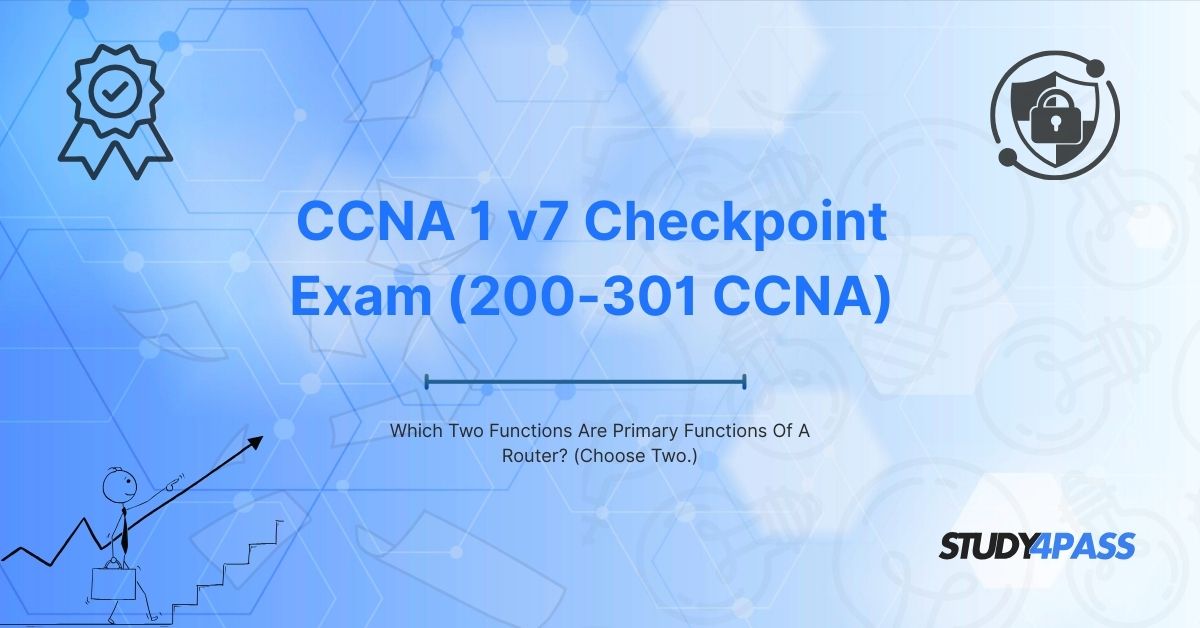Introduction
In the world of networking, routers play a crucial role in ensuring seamless communication between devices across different networks. For students preparing for the CCNA 1 v7 Checkpoint Exam (200-301 CCNA), understanding the primary functions of a router is essential. Among the various responsibilities of a router, two stand out as the most fundamental:
- Packet Forwarding
- Path Selection (Routing)
This article will explore these two primary functions in detail, along with their significance in network operations. Additionally, we will discuss how Study4Pass can help aspiring network professionals master these concepts and excel in their Cisco certification exams.
Packet Forwarding: Delivering Data Efficiently
What is Packet Forwarding?
Packet forwarding is the process by which a router receives data packets from one network and sends them to their intended destination on another network. Routers examine the destination IP address in the packet header and determine the best outgoing interface to forward the packet.
How Does Packet Forwarding Work?
- Receiving the Packet: The router receives a data packet through one of its interfaces.
- Checking the Routing Table: The router checks its routing table to determine the next hop for the packet.
- Forwarding the Packet: Based on the routing table entry, the router sends the packet out through the appropriate interface.
Types of Packet Forwarding
- Unicast Forwarding: Sends packets to a single destination.
- Multicast Forwarding: Sends packets to multiple destinations.
- Broadcast Forwarding: Sends packets to all devices in a network (limited to the local network).
Why is Packet Forwarding Important?
Without packet forwarding, communication between different networks would be impossible. Routers ensure that data reaches its intended destination efficiently, reducing network congestion and improving performance.
Path Selection (Routing): Determining the Best Path
What is Path Selection?
Path selection, also known as routing, is the process of choosing the most efficient path for data packets to travel from the source to the destination. Routers use routing protocols (such as OSPF, EIGRP, and BGP) to determine the best route.
How Does Path Selection Work?
- Building the Routing Table: Routers exchange information with other routers to build a routing table, which contains network paths.
- Evaluating Routes: The router evaluates multiple paths based on metrics like hop count, bandwidth, delay, and reliability.
- Selecting the Best Path: The router selects the optimal path and updates its routing table accordingly.
Types of Routing
- Static Routing: Manually configured routes by a network administrator.
- Dynamic Routing: Automatically updates routes using routing protocols.
Why is Path Selection Important?
Efficient path selection ensures:
Faster data transmission
Reduced network latency
Load balancing across multiple paths
Improved fault tolerance
Additional Functions of a Router (Secondary Roles)
While packet forwarding and path selection are the primary functions, routers also perform other important tasks:
1. Network Address Translation (NAT)
- Allows multiple devices on a local network to share a single public IP address.
- Enhances security by hiding internal IP addresses.
2. Access Control & Security (ACLs, Firewall Features)
- Implements Access Control Lists (ACLs) to filter traffic.
- Provides basic firewall capabilities to block malicious traffic.
3. Quality of Service (QoS) Management
- Prioritizes critical traffic (e.g., VoIP, video streaming) over less important data.
4. DHCP Services
- Assigns IP addresses dynamically to devices in a network.
How Study4Pass Helps You Master CCNA Concepts?
Preparing for the CCNA 1 v7 Checkpoint Exam (200-301 CCNA) requires a deep understanding of networking fundamentals, including router functionalities. Study4Pass is an excellent resource for Cisco certification aspirants, offering:
Comprehensive Study Guides – Detailed explanations of CCNA topics, including router functions.
Practice Exams – Simulates real CCNA exam questions to test your knowledge.
Hands-on Labs – Virtual labs to practice router configurations.
Expert Support – Access to networking professionals for doubt clarification.
By using Study4Pass, you can gain confidence in tackling CCNA exam questions related to packet forwarding, path selection, and other router functionalities.
Conclusion
Understanding the **two primary functions of a router—packet forwarding and path selection—**is crucial for anyone pursuing the CCNA 1 v7 (200-301 CCNA) certification. These functions ensure efficient data transmission across networks, making routers indispensable in modern networking.
For students aiming to excel in their CCNA exams, Study4Pass provides the necessary tools, practice tests, and expert guidance to master these concepts effectively.
Start your CCNA journey today with Study4Pass and take a step closer to becoming a Cisco Certified Network Associate!
Special Discount: Offer Valid For Limited Time “200-301 Exam Material”
Sample Questions for Cisco 200-301 Exam Prep Practice Test
Actual exam questions from Cisco's 200-301 Exam
1. Which of the following are primary functions of a router? (Choose two.)
A) Transmitting electrical signals
B) Forwarding data packets between networks
C) Connecting devices within the same LAN
D) Determining the best path for data transmission
2. What are the two main roles of a router in a network?
A) Filtering MAC addresses and assigning IP addresses
B) Forwarding traffic between different networks and selecting optimal routes
C) Amplifying Wi-Fi signals and encrypting data
D) Managing power supply and cooling systems
3. Which two tasks does a router primarily perform?
A) Hosting web pages and storing files
B) Sending emails and blocking spam
C) Routing packets between networks and maintaining routing tables
D) Providing wireless connectivity and printing documents
4. Select the two correct functions of a router:
A) Acting as a DHCP server
B) Connecting multiple IP networks and making forwarding decisions
C) Generating electrical power for devices
D) Broadcasting TV signals
5. Which of the following best describes a router’s primary responsibilities?
A) Only providing Wi-Fi access
B) Forwarding data between networks and choosing the best path
C) Only blocking unauthorized access
D) Only converting analog signals to digital


